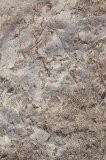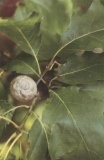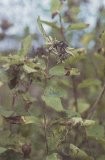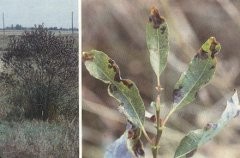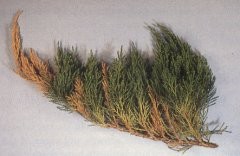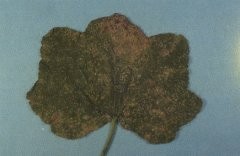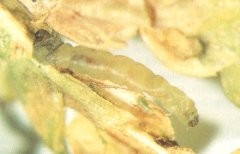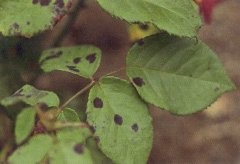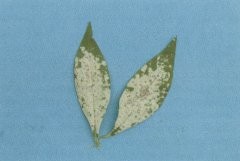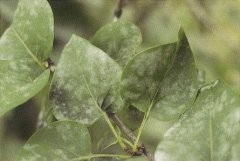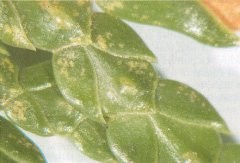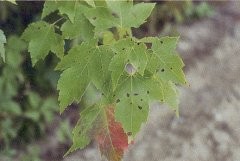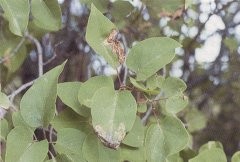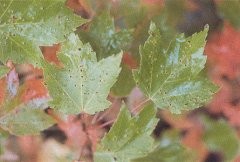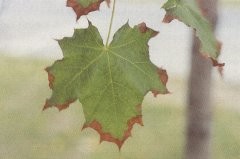Agdex No. 271.600
Snow Mold of Turf
Snow mold can be caused by two fungi Fusarium nivale or Typhula incarnata. Snow mold caused by Typhula incarnata begins under snow on unfrozen ground. As the snow recedes, brown, dead patches of grass can be seen. The patches are often bounded by a grey halo of fungus near their margins (Fig. 1). Careful inspection of dead grass may reveal tiny, round structures embedded in the leaf blade. Later in the spring and in the early summer Fusarium nivale usually causes snow mold. Diseased patches are similar to those caused by Typhula but close examination of dead grass will reveal tinges of pink or orange color. The disease is most severe where trees and shrubs cause shading and impede air circulation. Both types of snow molds are best controlled by proper cultural practices. In the early spring, when snow melt begins, reduce large piles and drifts of snow by shoveling or blowing. Consider the removal of scrub brush, bushes or fences which cause snow accumulation. In summer, cut grass to proper height and remove clippings after cutting. Continue grass cutting until growth ceases. When fertilizing, use a balanced fertilizer and avoid heavy applications of nitrogen. Chemical control is available.
Insect Galls on Oak
Oak galls (Fig. 2) can be caused by a variety of pests including mites, aphids, midges and wasps. The galls they create vary in size, appearance and location on the tree. These galls although they may affect the appearance of the trees, do not normally affect its health. Because the galls protect the developing pests, insecticidal control is rarely effective. If galls become unsightly they can be pruned out and destroyed.
Wooly Honeysuckle Aphid
The wooly honeysuckle aphid (Prociphilus xylostei) can cause considerable aesthetic damage to honeysuckle bushes and hedges. In severe infestations they may also reduce the growth and vigor of the affected bush. The aphid damages honeysuckle by feeding on it. This feeding induces the production of large tufts of leaves at the ends of branches (Fig. 3). The leaves within these tufts remain small and folded throughout the growing season. When folded leaves are pulled open and examined the aphid can often be found feeding inside. When the infestation is not severe, clipping off and destroying infested tufts when they are first noticed in the early spring may reduce the aphid population. If the problem reoccurs in consequtive years, spraying with an insecticide in the very early spring will provide control.
Willow Flea Weevil
The willow weevil (Rhynchaenus rufipes) feeds mainly on laurel-leaf willow, but it also may be found on weeping willow and occasionally lombardy poplar. The adult, which appears in June is a small (3mm, 1/8 inch) black, beetle. Adult feeding damage results in very small circular holes in the leaves. Larvae, present mid-July to mid-August, mine the leaves causing irregular light coloured blotches to occur. The blotches turn brown with age (Fig. 4). Heavy infestations of this insect cause entire trees to appear brown and severe defoliation may occur. Larvae pupate in the mines and emerge as adults in August. These adults feed until they overwinter. Insecticides are available to control this insect and should be applied in June when the adults are present and again in August if the problem still exists.
Juniper Blight
Juniper blight, caused by the fungus Phomopsis juniperovora, causes juniper branches to turn light brown and gtadually die back (Fig. 5). Pinpoint size, black, fruiting bodies containing the spores of the fungus, can often be seen on the infected area of the branches. When the spores are released they spread the disease to other juniper shrubs. When the disease is present in low incidence, prune out infected twigs and destroy them.
Rust of Hollyhock
The initial symptoms of hollyhock rust, caused by the fungus Puccinia malvacearum, are small yellow spots on the upper surface of leaves. On the lower surface of these leaves numerous orange to brown pustules containing the spores of the fungus are present. As the disease progresses affected leaves turn yellow and drop. Severe infections may result in stunting of plants, delayed blooming and few flowers. The disease can be spread to new hollyhocks from infected volunteer or neglected hollyhocks nearby. Do not plant new hollyhocks near old plantings. In the spring, examine all new growth for the symptoms of hollyhock rust. (Fig. 6). If the disease is present, fungicide sprays are available to control it. At the end of the season remove the old stems and destroy them along with any leaves or plant refuse at the base of the plants.
Cedar Leaf Miner
Damage caused by cedar leaf miners is often easily confused with winter damage as both cause a dieback of branches. However, "mined" leaves are nearly empty, and will appear translucent when held up to the light. Careful examination will often reveal pinpoint sized holes in the damaged leaves where the insect has exited. With very early detection, insect larvae may still be found feeding within the leaf (Fig. 7). Feeding begins in early spring and continues until the insects mature in early June to mid-July when the adults emerge. The adults are small moths which usually remain near the same tree from which they emerged. After mating, eggs are deposited on the cedar where the resulting larvae feed and then pass the winter. Feeding commences again in the spring. In all but severe infestations, this problem can be controlled by pruning and destroying infested branches before the adults emerge. Chemical control is available.
Blackspot of Rose
Rose blackspot, caused by the fungus Diplocarpon rosae, is the most important disease of garden roses world wide. This disease can become quite severe in home garden plantings. The most noticeable symptoms are the black spots with yellow halos that are formed on the leaves (Fig. 8). These spots rapidly grow together causing entire leaves to yellow and die. On stems, raised, purple/red blotches develop and progress to become blackened bistered areas. These spots rarely kill the stems but are important in the overwintering of the fungus. Petals of infected blossoms may have red flecks and are often distorted. Spores produced on leaf spots spread the disease to other rose plants. The fungus survives through winter on stem spots and fallen leaves and infects nearby roses the following spring. Due to this, infected stems should be pruned out and diseased leaves should be removed from the plant and ground in the fall and destroyed. This disease is favored by high humidity so it can be especially severe in dense plantings. Plant and prune roses to allow good air circulation. Fungicides are available to control this disease.
Powdery Mildew Diseases
Powdery mildews are a group of fungal diseases infecting many different plants including landscape and bedding plant species. These diseases, however, are specific and powdery mildew from one type of plant will not infect another type of plant. Lilac (Fig. 10) and phlox (Fig. 9) have typical symptoms of powdery mildew. The leaves are coated with a white floury material (the fungus) which usually covers most if not all of the leaf. Buds and young shoots may also be affected in a similar manner. The powdery appearance is due in part to large numbers of spores, which when released can cause new infections. This disease is most commonly found on plants growing in damp shaded locations or in crowded groupings. To control powdery mildews remove and destroy infected plant parts when affected area is small. Do not over water. Do not use excessive applications of nitrogen which promotes the growth of succulent tissue that is more succeptible to infection. Use pruning and proper spacing to increase air circulatioii. Both protective and curative fungicides are available.
Lilac Leafminer
The adult lilac leafminer (Gracillaria syringella) is a brown moth of about 6 Mul (1/4 inch). In the later part of May or early June it begins laying eggs. The eggs hatch in 7-10 days and the small green larvae begin feeding inside the leaves. This causes the affected areas of the leaves to turn brown and curl up (Fig. 11). Severely affected bushes and hedges appear as if they were scorched by fire. After approximately 3 weeks of feeding the larvae roll the leaves and feed inside the roll. Ten days later they drop to the ground to pupate. A second generation of moths appear in early August. The larvae of this generation feed until fall at which time they enter the soil and overwinter as pupae. Insecticides' are available to control this insect.
Mites on Cedar
A number of species of mites can damage juniper and cedar shrubs. These mites are so small they are best seen with the aid of a hand lens. They feed by sucking plant juices which causes browning or mottling of the foliage (Fig. 12). When large populations of mites are present, fine webbing may be seen on leaves and branches. Extensive mite damage may stress the shrub. Mite populations may be reduced by spraying affected foliage with a strong stream of water from the garden hose. Repeat frequently. Dormant oil may be applied to foliage in very early spring to control mites. Insecticides for use during the season to control mites are also available.
Maple Galls
During the summer months many small, 1-3 mm diameter (1/16 - Y8 inch), black galls can often be seen on the upper surfaces of the leaves of maple trees. In some cases virtually every leaf on the tree may be affected. These galls are caused by the feeding of several species of mites which are so small they cannot usually be seen by the unaided eye. The mites, after passing the winter in bark cracks and other protected areas of the tree crawl to young leaves in the spring to begin feeding. During feeding the mites secrete a substance which causes the galls to,form. Newly formed galls are green, turning red then black with age (Fig. 13). These galls may occasionally become unsightly but they usually do not adversely affect the health of the trees.
Tar Spot of Maple
Tar spot of maple is caused by the fungus Rhytisma acerinum. This disease begins as yellow green, oval to irregular spots on the upper surfaces of maple leaves. These spots enlarge and become raised, and blackened as they age (Fig. 14). Close examination of the spots will reveal a serpentine pattern. The fungus survives the winter in these spots on fallen leaves. In the spring, the fungus produces spores which are carried to newly emerged leaves of maple trees where they cause new infections. This disease can be best controlled by raking up infected leaves and burning or composting them under several inches of soil.
Maple Scorch
Abundant but not excessive soil moisture is essential for proper growth of trees. When adequate moisture is not available to trees because of the physical proximity of roots to pavement or due to salt from road de-icing entering the tree root zone, moisture stress symptoms occur. The common symptom of moisture stress in maple trees and other broad leaf trees is leaf scorch. This symptom involves the browning of leaf margins while the center of the leaves near the veins remain green (Fig. 15). The majority of the leaves on the trees are usually affected and midsummer leaf drop often occurs. When these symptoms persist for more than one year gradual tree decline occurs. To control this problem add thick mulches to roadside trees. When selecting trees for roadside planting or location near driveways choose those species which will adapt most easily to low moisture conditions. Your local Department of Agricultural or nursery can aid you with this selection. Trees experiencing severe and continual moisture stress should be watered. Water over a 12 hour period with a slow running hose that is periodically moved to allow thorough wetting of the root zone. If digging or land reshaping has to be carried out near the tree, take measures to minimize root damage.
Willow Blight
Willow blight can be caused by either of two fungi; Venturia saliciperda or Physalospora miyabeana. These fungi attack leaves, twigs, and branches causing defoliation, cankers and dieback. The initial symptoms of willow blight are brown, irregular spots on leaves and small twigs. The infected leaves turn red to brown and eventually wither and drop. As the disease progresses young shoots or twigs may be killed, while cankers form on the larger branches. Lower sections of the tree usually sustain more severe damage. Recurrent attacks by these fungi may cause tree death. Since the fungi overwinter in the diseased areas of the tree, infected twigs and branches should be pruned out and destroyed while trees are dormant. Chemical control is available and when warranted should be applied prior to bud break in the spring.
Winter Damage on Cedar
Winter damage of cedar and other evergreens often occurs in late winter on warm windy days when the ground is still frozen. The warmer winds cause the cedar to begin to transpire but the roots cannot obtain water from the frozen ground to replace the water lost through transpiration. This causes drying of the foliage to occur. The symptoms of winter damage, leaf scorch and tip browning, do not become evident until the spring when affected foliage becomes yellow to dark brown. Winter damage most commonly occurs when sensitive species of shrubs are planted in exposed locations. Burlap screens or wraps around the trees may prevent or reduce winter drying. Where symptoms reoccur antitranspirant sprays may be helpful in reducing damage.
Honeydew
Honeydew is a familiar problem in many landscapes. This clear sticky, substance can often be found covering picnic tables, cars, walkways, driveways, roads and landscape plants. In many cases black molds colonize the honeydew within a few days. Honeydew is secreted during the feeding of aphids, which are small insects found inhabiting most plants and trees. Large numbers of these insects feeding in landscape trees cause a virtual rain of honeydew to fall on anything located below them. Neither honeydew nor the sooty molds which grows on it damages objects. However, honeydew may become a hazard to pedestrains and cars during rainy periods as it may become slippery. Honeydew and sooty molds rarely harm plants unless large areas of their leaves are covered. If honeydew and sooty molds become unsightly thoroughly hose down the affected area with a strong stream of water. Insecticide sprays to kill the aphids will eliminate the problem, however spraying a large tree is difficult and best left to a professional.
To obtain chemical control recommendations consult your local agricultural representative.
Publication Funded by Agriculture Canada and the New Brunswick Department of Agriculture, Aquaculture and Fisheries under the Canada/New Brunswick Agri-Food Agreement (1984-1989)

